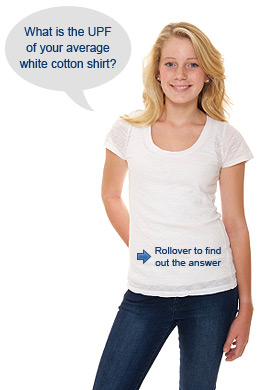Protective Clothing

Clothes can offer good protection to your skin from the sun however it is important to know that some clothes are better than others. Factors that affect the level of sun protection provided by a fabric include:
- Weave - tighter weave or knit improves the rating
- Fibre - polyester is often better than cotton
- Colour - darker colours are generally better
- Stretch - more stretch lowers the rating
- Moisture - many fabrics have lower ratings when wet
- Condition - worn and faded garments may have reduced ratings
- Finishing - some fabrics are treated with UV absorbing chemicals
Clothing is rated on the basis of its Ultraviolet Protection Factor (UPF). It indicates how effectively fabrics shield your skin from ultraviolet (UV) rays. The higher the UPF number, the greater degree of UV protection a garment offers. A fabric with a rating of 50 will allow only 1/50th of the sun's UV rays to pass through. This means the fabric will reduce your skin's UV radiation exposure significantly, because only 2 percent of the UV rays will get through. This is in contrast to the Sun Protection Factor (SPF) which is the rating system used for sunscreens. SPF measures the amount of time it takes for sun-exposed skin to redden, whereas UPF measures the amount of UV radiation that penetrates a fabric and reaches the skin.
Clothing manufacturers can apply to the Federal Government to have their garments tested for the amount of UV light that they transmit and are then rated according to the following table:
| UPF Range | Protection Category | Effective UV Transmission (%) | UPF Rating |
| 15-24 | Good | 6.7-4.2 | 15, 20 |
| 25-39 | Very Good | 4.1-2.6 | 25, 30, 35 |
| 40-50 | Excellent | 2.5-2.0 | 40, 45, 50 |
| 50+ | Ultimate | Less than 2 | 50+ |
 Garments with higher UPF values provide better protection against UV penetration and therefore sun damage to your skin. As a general rule, thicker, darker fabrics with tighter weaves are best. A good guide is to hold you garment to the light – if you can see through it, chances are the UV can penetrate through it also!
Garments with higher UPF values provide better protection against UV penetration and therefore sun damage to your skin. As a general rule, thicker, darker fabrics with tighter weaves are best. A good guide is to hold you garment to the light – if you can see through it, chances are the UV can penetrate through it also!
When fabrics are wet the UPF rating may decrease. For example, the UPF of your average white cotton shirt is only about 5-10 when dry. If it is wet the UPF will come down to about 2, which means that 50% of UV light will pass through. Sun-protective clothing will also lose its effectiveness if it is stretched and with repeated use and washing.
Clothing protection should always take priority over protection with sunscreens. Mainly because we usually do not apply enough sunscreen, we fail to reapply it, or it washes off. Besides the important sun minimisation strategies like seeking the shade, clothing with a high UVP is the ideal protection for outdoor workers and swimmers.
What is Your Skin Cancer Risk?
Calculate your level of risk of developing a skin cancer from exposure to the sun.

